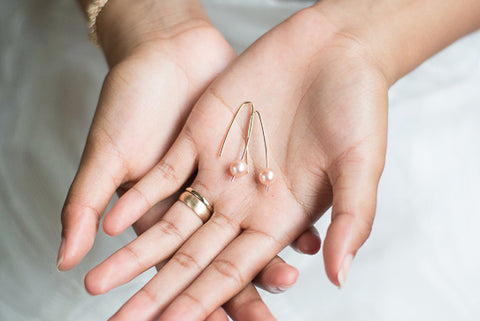Saltwater Beauties

June is here and that means Pearl month has officially begun! Although most popular throughout the 1920’s-1950’s, pearls continue to be a classic, timeless statement of modesty, refinement, and everlasting beauty.
But how much do you really know about pearls?
Pearls have been treasured for thousands of years. In fact, the earliest known written mention of pearls goes back to 2206 BC. As with all gemstones, the wealthiest and most powerful patrons throughout Europe and Asia brought about demand for pearls. This inevitably raised awareness and popularity for pearls amongst the masses. After the discovery and exploitation of the new world, newly found natural pearl sources in Venezuela and Panama, respectively, intensified European demand.
For a few hundred years natural pearls remained a commodity only for the wealthy, those whom could afford such rare and exquisite luxuries. It was the turn of the 20thcentury that slowed down the demand for natural pearls by changing the rules of the game, forever. It was around this time that Chinese and Japanese pearl enthusiasts perfected the production of cultured pearls. The beginning of the cultured pearl industry expanded the consumer pool, making pearls accessible to a larger population than ever before.
But, where do these lovely round orbs come from? Pearls are an organic gemstone grown on the mantle or gonad of a live mollusk. Pearls come from both saltwater and freshwater mollusks. Essentially what happens (in nature) is a piece of organic matter gets lodged inside the mollusk causing an irritation. The mollusk then secrets nacre over the impurity, causing the growth of a pearl over time. The time it takes for a mollusk to grow a pearl can vary quite significantly- starting from six months to taking nearly a decade! My oh my, these mollusks are hard workers!
Pearl cultivators “impregnate” the mollusks with a “seed” made from mollusk mantel or shell and continuously care for the mollusks to ensure pearl growth. For this process, mollusk farms were created off the shores of China, Japan, Australia, Polynesia, and others. The same can be said for rivers and lakes, where freshwater pearls are cultivated. You may even find it a bit surprising that there are freshwater pearl farms right here in the good ol’ USA!
There are over three dozen types of pearl producing mollusks known today, but only about half of those are used in the pearl cultivating industry. The most popular kinds of pearl-producing mollusks are the Akoya (saltwater), Tahitian (saltwater), South Sea (saltwater), and Freshwater mollusk. Each type of mollusk produces a specific type of pearl, the most popular being the Akoya pearl. Akoya pearls are famous for their high luster and perfectly round proportions.
You can find pearls in just about every color and hue! No, really! Every color you can imagine. Yet the most common, based on popularity, are neutral tones such as white and cream. Respectively, the peacock color seen only in Tahitian pearls, boomed in popularity after its introduction to the fashion industry in the 1970s. Today, Tahitian pearls continue to grow in popularity, as many jewelry designers take advantage of their exotic coloring.
Truly, no other jewelry item (with the exception of the solitaire engagement ring), is as iconic to the industry as the standard Akoya pearl necklace. Pearls are not only representative of purity, beauty, and the loyalty of its wearer, they represent so much more. Pearls are there to remind us how incredible nature is, and how truly incredible human beings can be. We really are capable of just about anything. Without human innovation, 99% of the human population would not have access to pearls and many other luxuries today. In fact, 99% of us would go about our entire lives without ever getting the chance to see a pearl in real life. Imagine that?
